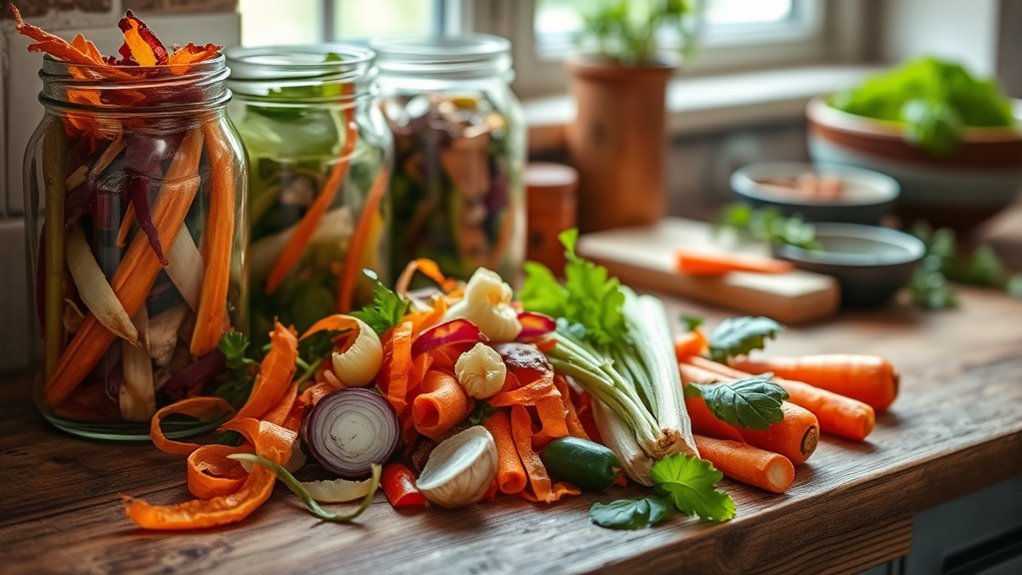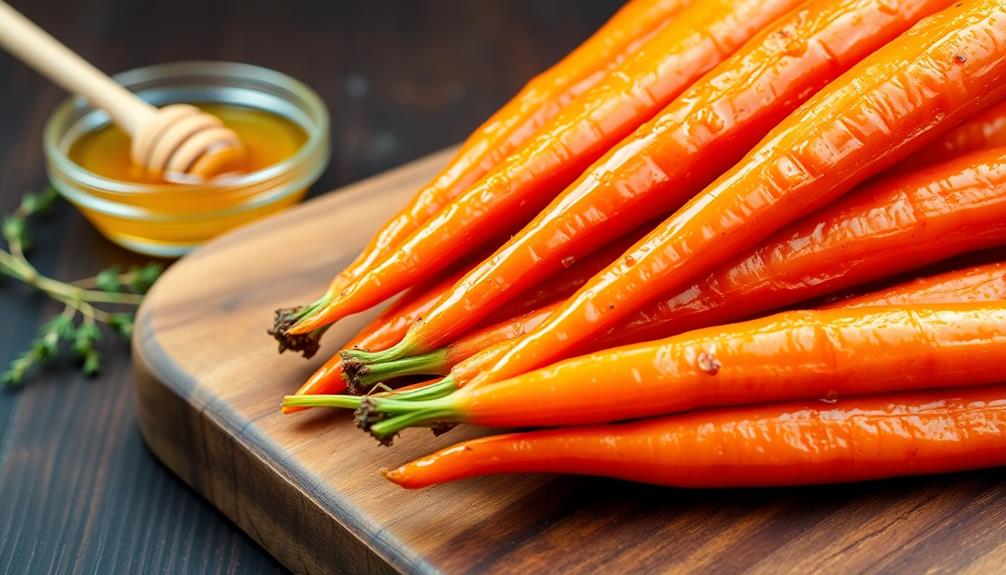To boost sustainability in your kitchen, start using leftover scraps like vegetable peels, eggshells, and coffee grounds for composting. This reduces waste and creates nutrient-rich soil that nourishes your plants. Keep a designated bin nearby, and balance green and brown materials for effective composting. Switching to eco-friendly cookware and making small daily changes can have a big impact. Continue exploring how these simple actions can help you create a more sustainable kitchen environment.
Key Takeaways
- Collect vegetable scraps, coffee grounds, and eggshells for composting to reduce waste and enrich soil.
- Balance green and brown materials in your compost bin to improve decomposition and sustainability.
- Use sustainable cookware made from eco-friendly materials to lower environmental impact and promote durability.
- Incorporate composting into daily routines to minimize kitchen waste and support natural fertilizer creation.
- Make conscious choices by reducing waste, reusing scraps, and adopting eco-friendly practices for a greener kitchen.

Sustainability in the kitchen is more important than ever as we seek to reduce our environmental impact and make healthier choices. One of the simplest yet most effective ways to do this is by developing composting habits. Instead of tossing vegetable scraps, coffee grounds, eggshells, and fruit peels into the trash, you can turn them into nutrient-rich compost. Not only does this cut down on landfill waste, but it also creates natural fertilizer for your garden or indoor plants. Composting helps close the loop in your food cycle, ensuring that scraps support new growth rather than polluting the environment. To get started, you’ll want to designate a compost bin close to your kitchen. Keep it covered to contain odors and make it easy to access when you’re preparing meals. Remember to balance green materials, like vegetable scraps, with browns such as shredded paper or dried leaves. Over time, you’ll see how this habit reduces your waste and benefits your outdoor space or houseplants. Incorporating composting methods can further enhance the effectiveness of your waste reduction efforts.
Alongside composting, choosing eco-friendly cookware plays an indispensable role in sustainable kitchen practices. Traditional pots and pans often contain materials that are harmful to the environment or difficult to recycle. Switching to eco-friendly cookware made from sustainable materials like cast iron, stainless steel, or ceramic can markedly reduce your ecological footprint. These options tend to last longer, minimizing the need for frequent replacements, which reduces waste. Plus, many eco-friendly cookware pieces are designed to be energy-efficient, cooking food more evenly and reducing the time and energy needed for meal prep. When shopping, look for products labeled as environmentally friendly, non-toxic, and durable. Using these types of cookware not only supports your sustainability goals but also promotes healthier cooking and eating habits.
Integrating composting habits and eco-friendly cookware into your routine is about more than just individual actions; it’s about creating a mindset that values resourcefulness and respect for the environment. When you prioritize composting, you’re actively reducing waste and enriching your soil naturally. Pairing this with the use of sustainable cookware means you’re making conscious choices that lessen the release of harmful chemicals and lower your energy consumption. Over time, these habits become second nature, changing how you approach food and waste in your kitchen. Small adjustments, like saving vegetable scraps or investing in durable, eco-friendly pots, can add up to a meaningful impact. The key is consistency—by making these practices part of your everyday routine, you help foster a more sustainable lifestyle that benefits both you and the planet.
Frequently Asked Questions
How Can I Compost Kitchen Scraps Effectively at Home?
You can compost kitchen scraps effectively at home by starting a worm composting system with vermiculture bins. Place your scraps like fruit peels and coffee grounds into the bin, and let worms break them down naturally. Keep the bin moist and aerated, and position it in a shady spot. This method speeds up composting and reduces waste, making your kitchen scraps eco-friendly and useful for your garden.
Are There Specific Storage Tips for Leftover Scraps to Prevent Spoilage?
You might worry about messy leftovers, but proper container storage keeps things fresh. Use airtight containers and store scraps in a designated spot in your fridge or freezer. Label each container clearly, so you know what’s inside and avoid spoilage. Organize scraps by type or date, making it easy to find what you need for composting or cooking, reducing waste and keeping your kitchen tidy.
What Are Creative Ways to Reuse Vegetable Peels and Stems?
You can get creative with vegetable peels and stems by turning them into plant decor or vegetable craft ideas. For example, dry peels to make natural potpourri or use stems to propagate new plants. You might also weave peels into wreaths or create mini garden arrangements. These ideas not only reduce waste but add a fun, eco-friendly touch to your home, showcasing your resourcefulness and love for sustainability.
How Do I Identify Which Scraps Are Safe to Recycle or Compost?
Think of your scraps as potential treasures, each with a story to tell. To safely identify which scraps to recycle or compost, follow clear composting guidelines—avoid meats, dairy, and oily foods, which can attract pests. Green scraps like vegetable peels and stems are typically safe, but always check for mold or rotting. When unsure, consult local composting resources to ensure you’re nurturing the earth responsibly.
Can Leftover Scraps Be Used to Make Homemade Broths or Stocks?
Yes, you can definitely use leftover scraps to make homemade broth. Collect vegetable peels, onion skins, garlic ends, and herb stems, then simmer them in water for a flavorful base. This not only reduces waste but also creates a nutritious homemade broth. Just make certain scraps are clean and free of any spoiled or non-edible parts. Strain the broth, and you’re ready to use it in soups, stews, or rice dishes!
Conclusion
By choosing to use leftover scraps, you’re making a real difference—reducing food waste and conserving resources. Did you know that approximately one-third of all food produced globally is wasted? That’s enough to feed the world’s hungry twice over. So, next time you clean out your fridge, remember that small actions like repurposing scraps can add up to big environmental benefits. Every bit counts when it comes to creating a more sustainable kitchen.










